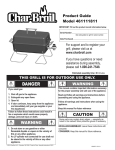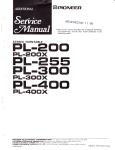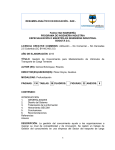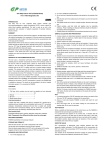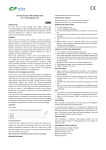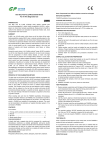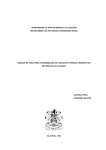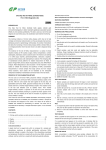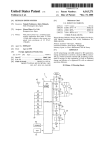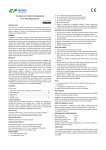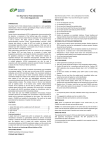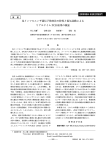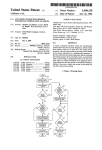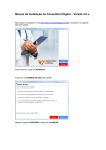Download One Step Test for D-Dimer
Transcript
One Step Test for D-Dimer (Colloidal Gold) For In Vitro Diagnostic Use months. o Suggest storing the blood sample diluent at 2~8 C for a better use. WARNINGS AND PRECAUTIONS Manual INTENDED USE One Step Test for D-Dimer (Colloidal Gold) applies colloidal gold immunochromatography to detect D-Dimer in plasma or whole blood samples quantitatively. The test is used as an aid in the assessment and evaluation of patients suspected of having deep-vein thrombosis or pulmonary embolism. SUMMARY Suspected deep-vein thrombosis is a common condition, with a lifetime cumulative incidence of 2 to 5 percent. Untreated deep-vein thrombosis can result in pulmonary embolism, a potentially fatal outcome. Anticoagulant therapy reduces both morbidity and mortality from venous thromboembolism, and early diagnosis is therefore important. Accurate diagnosis of deep-vein thrombosis minimizes the risk of thromboembolic complications and averts the exposure of patients without thrombosis to the risks of anticoagulant therapy. D-Dimer is a marker of endogenous fibrinolysis and should therefore be detectable in patients with deep-vein thrombosis. In recent years, an increasing number of studies have shown the D-Dimer assay to have a high negative predictive value and D-Dimer to be a sensitive but nonspecific marker of deep-vein thrombosis. Negative D-Dimer can exclude deep-vein thrombosis and pulmonary embolism. PRINCIPLE OF THE EXAMINATION METHOD The test uses a monoclonal anti-human D-Dimer antibody conjugated with colloidal gold and another monoclonal anti-human D-Dimer antibody coated on the test line. After the sample has been applied to the test strip, the gold-labelled monoclonal anti-human D-Dimer antibody binds to the D-Dimer in sample and forms a marked antigen-antibody complex. This complex moves to the test card detection zone by capillary action. Then marked antigen-antibody complex is captured on the test line by the monoclonal anti-human D-Dimer antibody resulting in a purplish red streak appears on the test line. The color intensity of the test line increases in proportion to the amount of D-Dimer in sample. Then insert test card into the FIA8000 Quantitative Immunoassay Analyzer (hereafter referred to as FIA8000), the concentration of D-Dimer is measured and displayed on the screen. The D-Dimer concentration is stored in the FIA8000 and is available on demand. The result can be transmitted to the lab or hospital information system, if it is connected to FIA8000. CONTENTS A kit contains: 1. Foil bag, which contains one test card, one pipette and one desiccant ···························································· 25 2. Manual ················································· 1 3. SD card ··············································· 1 4. Blood sample diluent ······························· 25 A test card consists of: A plastic shell and a reagent strip which is composed of a sample pad, a colloidal gold pad (coated with a gold-labelled anti-human D-Dimer monoclonal antibody), nitrocellulose membrane (the test line is coated with another anti-human D-Dimer monoclonal antibody, and the control line is coated with rabbit anti-mouse IgG antibody), absorbent paper and liner. Blood sample diluent: Phosphate buffered saline, proteins, detergent, preservative, stabilizer. Note: Components from different batches cannot be exchanged. MATCHING EQUIPMENT FIA8000 Quantitative Immunoassay Analyzer STORAGE AND STABILITY Store the test card at 4~30oC with a valid period of 24 months. Use the test card within 1 hour once the foil bag is opened. Store the blood sample diluent at 0~30oC with a valid period of 24 1. For In-Vitro diagnostic use. 2. For use by healthcare professionals. 3. Do not use the kit beyond the expiration date printed on the outside of the box. 4. Keep the test card in the sealed pouch until ready to use. Do not reuse the used cards. 5. The pipette should not be used for multiple samples. Discard it after single use. 6. Patient samples, used test cards and pipettes may be potentially infectious. Proper handling and disposal methods should be followed in accordance with local regulations. 7. Carefully follow the instructions and procedures described in this manual. SAMPLE COLLECTION AND PREPARATION 1. A plasma or whole blood sample can be used for testing with this product. Plasma is a better option for test accuracy. Samples should be free of hemolysis. 2. Sodium citrate needs to be used as anticoagulant. 3. If testing cannot be completed immediately, the plasma sample should be stored up to 3 days at 2~8oC or stored at -20oC for 1 months (whole blood sample should be stored up to 3 days at 2~8oC) until it can be tested. 4. Samples must be recovered to room temperature before testing. Frozen samples are required to be completely thawed and mixed thoroughly prior to testing. Minimize repeat freeze-thaw cycles to less than 3 times for tested samples to acquire accurate data. 5. Avoid heating the samples, which can cause hemolysis and protein denaturation. 6. SAMPLE VOLUME: 120 μl plasma or 180 μl whole blood. TEST PROCEDURE 1. Restore samples, sealed test-card foil bags and blood sample diluent to room temperature before using. Open the foil bag, label cards with numbers and use the test cards immediately. 2. Confirm SD card lot No. in accord with test kit lot No.. Perform “QC SD” operation (Details refer to 8.3.1 of FIA8000 User’s Manual) when necessary. 3. Add 120 μl plasma or 180 μl whole blood to one tube of blood sample diluent, and mix gently and thoroughly. Drop 120 μl of sample mixture to the sample port on test card. Wait for 7 minutes, insert the card immediately into FIA8000 and press "OK" button, the test card can be detected and the result will be printed automatically. Note: 1. It is required to perform “QC SD” operation when using a new batch of kits; Only one “QC SD” operation is required for the same batch. 2. Assure of card side towards FIA8000 is correct and insert the card completely. 3. Don’t wait longer than 7 min before reading the card because the readings after 7 min won’t be accurate. TEST RESULTS When a purplish-red band appears in the control area, use FIA8000 to analyse the test card and get a quantitative result. If no purplish-red band appears in the control area, it indicates that the operation is incorrect or the test card has passed its expiration date. In this case, please read the manual again carefully and use a new test card to try again, if the problem persists, please stop using all products of the same batch immediately and contact with your supplier. EXPECTED VALUE D-Dimer concentration is determined using samples obtained from 500 apparently healthy individuals. The 95th percentile of the concentration for D-Dimer is 0.5mg/L. If the concentration of D-Dimer is less than 0.5 mg/L, it can be estimated as normal. PERFORMANCE CHARACTERISTICS Measuring Range: 0.1~10.0 mg/L Lower Detection Limit: ≤0.1 mg/L Within-Run Precision (n=10): ≤10% Between-Run Precision: ≤15% Recovery: 99% Method Comparison: The assay was compared to Sysmex CA7000 and the matching D-Dimer test kits with 200 patient plasma samples (60 positive samples, 140 negative samples). The correlation coefficient (r) is 0.978. DESCRIPTION OF SYMBOLS USED The following are graphical symbols used in or found on One Step Test for D-Dimer (Colloidal Gold) are the most common ones appearing on medical devices and their packaging. They are explained in more detail in the European Standard EN 980: 2008 and International Standard ISO 15223-1:2007. Key to symbols used LIMITATIONS OF THE PROCEDURE 1. The result of the test should be evaluated in the context of all the clinical and laboratory data available. In those instances where the laboratory results do not agree with the clinical evaluation, additional tests should be performed accordingly. 2. Some substances in blood can influence the result of the test, such as RF, human anti-mouse antibody and heterophile antibody. In this case, the test result should be combined with the clinical evaluation and additional tests. REFERENCES 1. Sarig G, Klil-Drori AJ, Chap-Marshak D, Brenner B, Drugan A. Activation of coagulation in amniotic fluid during normal human pregnancy.Thromb Res. 2011 Apr 18. 2. Roldán V, Marín F, Muiña B, Torregrosa JM, Hernández-Romero D, Valdés M, Vicente V, Lip GY. Plasma von Willebrand Factor Levels Are an Independent Risk Factor for Adverse Events Including Mortality and Major Bleeding in Anticoagulated Atrial Fibrillation Patients.J Am Coll Cardiol. 2011 Apr 11. 3. Sakamoto K, Yamamoto Y, Okamatsu H, Okabe M. D-dimer is helpful for differentiating acute aortic dissection and acute pulmonary embolism from acute myocardial infarction.Hellenic J Cardiol. 2011 Mar-Apr; 52(2):123~127. 4.EN ISO 18113-1:2009 In vitro diagnostic medical devices - Information supplied by the manufacturer (labelling) - Part 1: Terms, definitions and general requirements. 5.EN ISO 18113-2:2009 In vitro diagnostic medical devices - Information supplied by the manufacturer (labelling) - Part 2: In vitro diagnostic reagents for professional use (ISO 18113-2:2009). Manufacturer Expiration Date Do not re-use Date of manufacture Consult instructions Batch code for use Temperature In vitro diagnostic limitation medical device Authorized Sufficient for representative in the European Community CE marking Thank you for purchasing One Step Test for D-Dimer (Colloidal Gold). Please read this manual carefully before operating to ensure proper use. Version:131210


